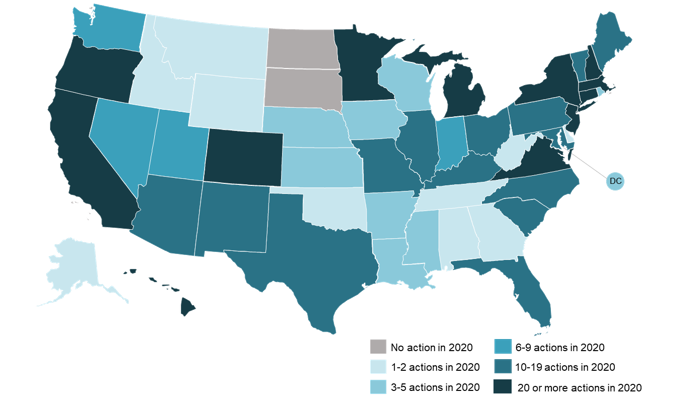The 50 States of Grid Modernization: Energy Storage and Utility Business Model Reforms Take Focus in 2020
Raleigh, NC – (February 3, 2021) The N.C. Clean Energy Technology Center (NCCETC) released its 2020 annual review and Q4 2020 update edition of The 50 States of Grid Modernization. The quarterly series provides insights on state regulatory and legislative discussions and actions on grid modernization, utility business model and rate reforms, energy storage, microgrids, and demand response.
The report finds that 48 states and the District of Columbia took actions related to grid modernization during 2020 (see figure below), with the greatest number of actions relating to energy storage deployment, utility business model reforms, smart grid deployment, customer data access policies, advanced metering infrastructure (AMI) rules, distribution system planning, and AMI deployment.
2020 State and Utility Action on Grid Modernization

The report highlights ten of the top grid modernization trends of 2020:
- Utilities pursuing innovative pilot programs;
- States considering utility business model reforms;
- Regulators requiring utilities to file distribution system plans;
- States requiring the use of all-source competitive procurement;
- States adopting energy storage targets;
- Utilities proposing advanced rate design pilots;
- Growing focus on electric grid resilience;
- Utilities planning extensive battery storage deployment;
- Policymakers considering AMI opt-out and data access policies; and
- Utilities offering smart thermostat incentive programs.
“Energy storage deployment was the most common type of grid modernization action for the fourth year in a row,” observed Autumn Proudlove, lead author of the report and Senior Policy Program Director at NCCETC. “We also saw new states adopt energy storage targets and movement toward all-source competitive procurements, which can allow energy storage resources to compete with traditional generation.”
A total of 658 grid modernization actions were taken during 2020, representing approximately an 8% increase in activity over 2019 (612 actions). The report notes that ten of the most active states in 2020 for grid modernization were:
- Connecticut, where regulators had numerous proceedings open related to grid modernization and state lawmakers enacted legislation to adopt a performance-based regulation framework;
- Hawaii, where the Commission issued a decision establishing a performance-based regulation framework and considered a draft microgrid services tariff;
- Virginia, where regulators issued a decision on Dominion Energy’s proposed Grid Transformation Plan and lawmakers established a statewide energy storage target;
- Colorado, where the Commission considered proposed distribution system planning rules, as well as performance-based ratemaking, electric resource planning, and interconnection rules;
- Minnesota, where the regulators investigated distribution grid data security and considered utility proposals to adopt performance incentive mechanisms and time-of-use rates;
- California, where regulators considered a proposed decision to facilitate microgrid development, as well as frameworks to promote non-wires alternatives;
- North Carolina, where a working group released a report examining utility business model reforms and Duke Energy announced plans for a southeast energy exchange market;
- New York, where the Commission approved AMI deployment proposals, as well as new dynamic load management programs to encourage the use of energy storage; and
- Arizona, where regulators issued a decision amending resource planning rules, requiring utilities to offer energy storage incentives, and adopting an energy storage target; and
- Michigan, where regulators continued the MI Power Grid initiative, releasing a demand response report and establishing a work group to examine new technologies and business models.
“One of the trends we observed this year was utilities proposing incentives to encourage residential customers to participate in demand response programs,” noted David Sarkisian, Senior Policy Project Manager at NCCETC. “While residential incentive programs in the past have typically focused on technology adoption, these programs compensate customers for enabling direct utility control through devices like smart thermostats and energy storage systems.”
In Q4 2020, 47 states and D.C. took some type of action on distributed solar policy or rate design. A total of 405 actions were tracked in Q4.
View the 50 States of Grid Mod 2020 Annual Review and Q4 Update Executive Summary
View and Purchase the 50 States of Solar 2020 Annual Review and Q4 Update FULL Report
View other 50 States Reports – Solar, Grid Modernization and Electric Vehicles
ABOUT THE N.C. CLEAN ENERGY TECHNOLOGY CENTER
The N.C. Clean Energy Technology Center, as part of the College of Engineering at North Carolina State University, advances a sustainable energy economy by educating, demonstrating and providing support for clean energy technologies, practices and policies. It serves as a resource for innovative, sustainable energy technologies through technology demonstration, technical assistance, outreach and training. For more information about the Center, visit: http://www.nccleantech.
Media Contact: Shannon Helm, NCCETC, shannon_helm@ncsu.edu